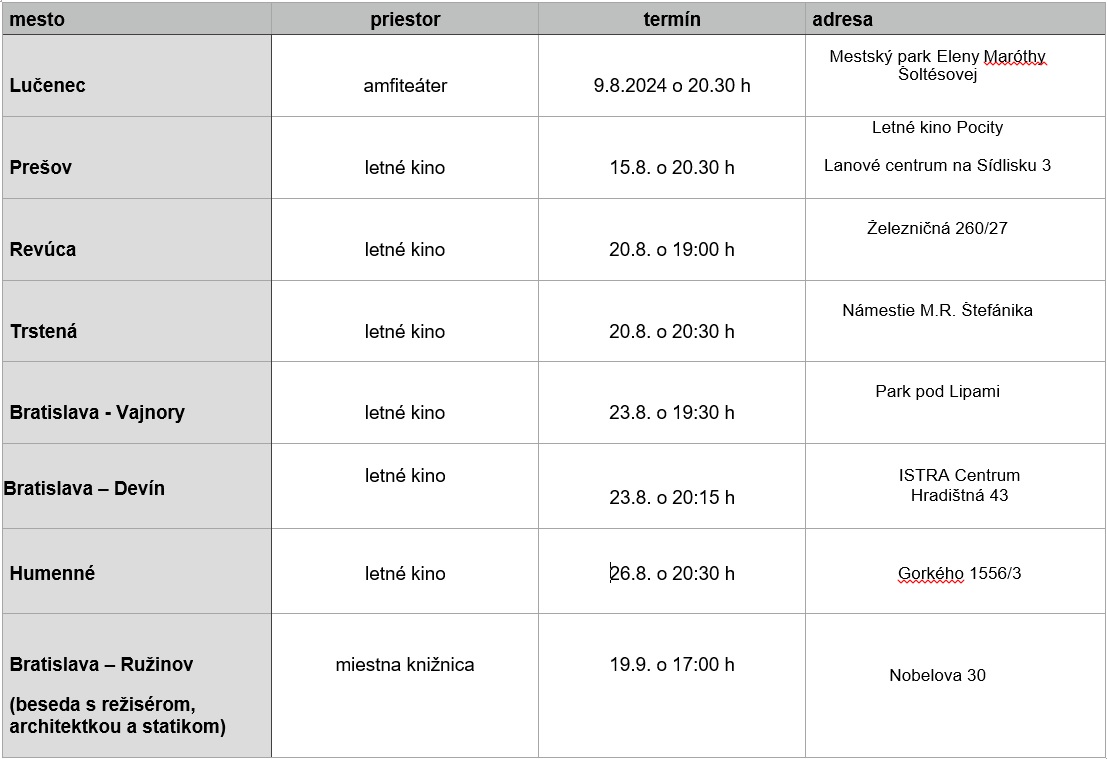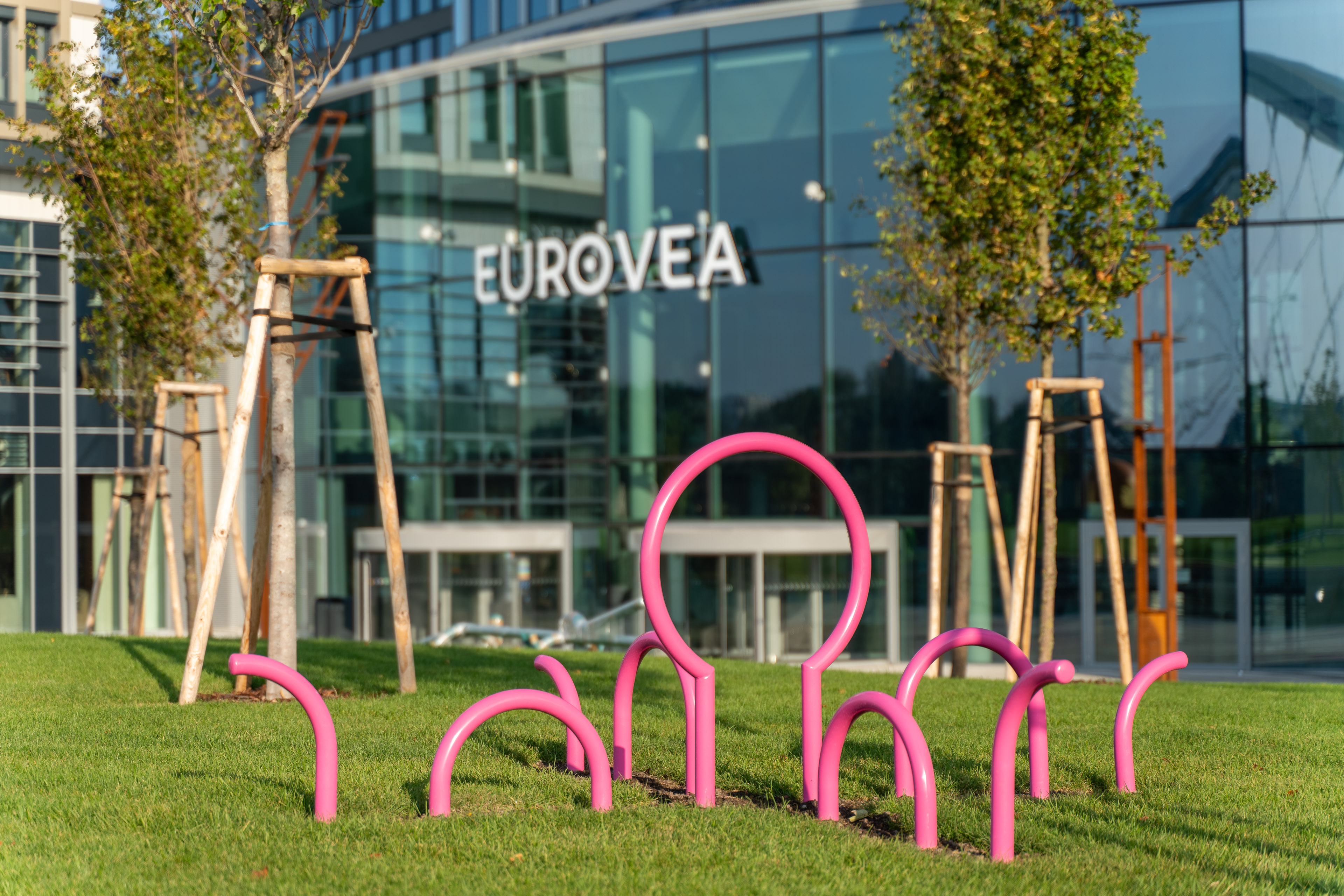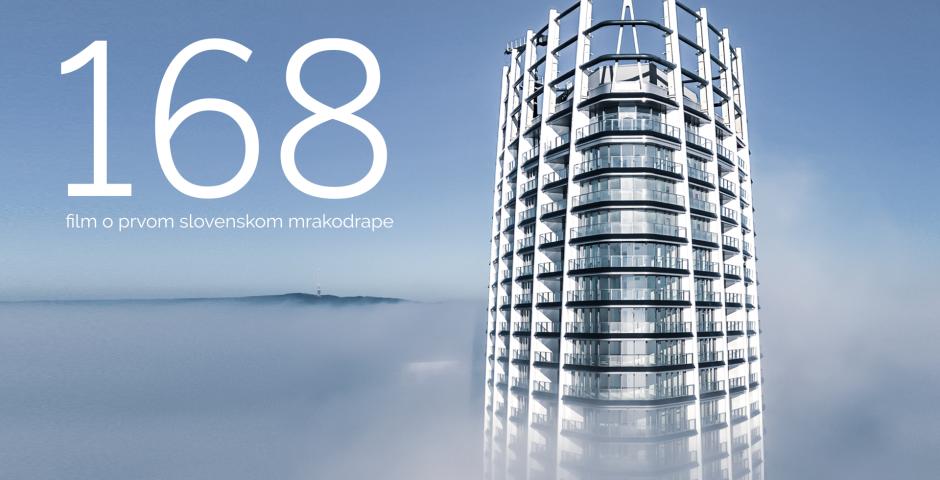168 – WHERE SLOVAKIA’S FIRST SKYSCRAPER TAKES CENTRE STAGE
This film tracks the whole story – from breaking ground to homeowners receiving their keys. The journey includes how the building was envisioned by the investor and architects, i.e. those who decided that now was the time for such a project in Slovakia: a construction dream brought to life. The film portrays the developer’s concept, and the lead architect team’s approach – as talking heads discuss the building’s USP and inspirational design. The construction’s technical aspects are put into the context of the human dimension: the can-do enthusiasm that drove the project to completion. The film also profiles some of the skyscraper’s homeowners, who see their incredible new property rise high into the air floor-by-floor, month-by-month. We explore their feelings about this unique building, their reasons for living there, and their expectations – the building’s construction process acts as a framing device for the prospective homeowners’ innovative ideas. Construction managers, labourers and designers also give their informed inputs. Although a historical city with a heritage stretching back far further than the Austro-Hungarian Empire, contemporary Bratislava is a young, dynamic and vibrant city. And this project sets a brilliant benchmark: the sensational story of a stunning new landmark on the capital’s skyline.
MEDIA COVERAGE:
Aktuality.sk
Spojená Bratislava
Startitup.sk
Slovenský filmový ústav (SFÚ)
Premium News
TRAILER:
WATCH AT:

COLOURFUL COMMEMORATIVE STATUE

The attractive Danube promenade extension is now welcoming visitors. This follows the opening of Eurovea shopping centre’s extension, enlarged adjacent public spaces, and the completion of office and residential buildings, including Eurovea Tower - the first Slovak skyscraper. To mark this grand opening, the Octahedral Body statue was unveiled in the new riverside square. Sculptor Viktor Frešo - a leading contemporary Slovak artist - won JTRE’s visual artwork public competition. The five-member jury appraised 25 proposals submitted by Slovak and Czech artists in June 2022, with the top-three creators awarded at the Warehouse 7 exhibition opening.
The thirteen-metre-high abstract figure, based on the artist's self-portrait theme, comprises 2.2- to 2.65-metre coloured spheres arranged on a steel structure. The jury appreciated its balanced elemental form that will deliver the prerequisite urban-spatial accent in this architectural context. The statue is characterised by a distinctive silhouette, legible structure, and elementary colours.
"The jury is confident that the selected design will create another strong city-forming feature that will embrace 21st century visual language, and contribute to public space in Bratislava," said Vladimír Beskid (jury member, director of Trnava’s Jan Koniarek Gallery, curator and contemporary art critic). "We sought both strong visuals and symbolic meaning," added Zuzana Pacáková (jury member jury and expert consultant, and Biele Noc artistic director ). "Something unique happened here, rather special in Slovakia, that the developer sought large-scale contemporary art. I’m delighted that it will be located here," observed Viktor Frešo as the artwork was assembled. JTRE shapes space for art - Octahedral Body complements other artworks such as Mythical Ship and Bronze Sharks (River Park), and Messerschmidt's Character Heads and Frešo's Circle Head (Zuckermandl).
Viktor Frešo is a Slovak conceptual artist, photographer, painter, sculptor and musician. His works and approach to art are very atypical, while strongly reflecting social and cultural themes. His concepts and projects seek a critical stance, and assertively express a certain ambivalence towards contemporary art through undercurrents of lightness and humour. His art embraces ego and self-irony.
BIG FUN WITH MINIMALIST PLAYTHINGS

Eurovea’s picturesque riverside landscaping also features Minimalist Playthings (which premiered at Milan Design Week in 2021 to great acclaim) by award-winning designer Luca Boscardin. Venturing beyond the passive aesthetic, this project invites creative interactions by passers-by. They can be viewed as exercise stations, parkour positions, children's games, or just somewhere unconventional to sit. The Danube riverbank’s six pieces - tortoise, walrus, octopus, crocodile, pelican and whale - will complete the "family" of animals in squares and parks dotted around the world.
Luca Boscardin studied architecture and graphic design at IUAV, Venice. He lives and works in Amsterdam as an illustrator, toy and icon designer for Philips. In 2016, he launched the BLUC toy brand with a collection of rocking animals, which was exhibited at the Vitra design museum and at La Triennale. He has published with Corraini Edizioni Tutti in Fila and Scarti d'Italia. He taught design at Abadir Academy, and collaborates with educational workshops at ISIA and Politecnico di Milano.
WELCOME TO NEW PUBLIC SPACES

Large public spaces form an integral part of Eurovea City, which is the heart of Bratislava's rapidly-developing contemporary city centre. The concept’s visionary is internationally-renowned architect Professor Beth Galí, who worked alongside the GFI Studio team to fine-tune the new promenade and city boulevard.
The developer, urban planners and architects aimed to create connections with the Danube and a smooth riverside transition. Urban pathways directly in Eurovea Tower’s forecourt became an important compositional element. The architecture was based on tried-and-tested philosophy, and the public spaces were an integral part of the urban concept. "Bratislava deserves to be reunited with the scenic Danube. Eurovea City is a leading Bratislava space where the water’s flow is accentuated, and where locals are encouraged to come," says Katarína Jägrová, GFI Studio architect. Beth Galí sought to create a visually non-invasive and tranquil space, with a harmoniously consistent urban district that has a specific yet intuitively flexible character that encourages open-minded use.
Inspired by the former wharf, shipping cranes, haulage rails, and industrial heritage, Galí repurposed the typical industrial low-alloy weathered steel for the streetlamps, flowerpots and water flows – a subtle historical reminder that contributes to the area’s contemporary radiance. “Pribinova boulevard is the central axis that connects the north and south areas – pedestrian-friendly with plenty of greenery, and traffic flow centred to free-up the sides for walking and other activities. Between the two car lanes is a dedicated path for bicycles, scooters and alternative transport," she adds.
Beth Galí is the visionary behind numerous public spaces (city beach promenade in Barcelona; central spaces in Cork; HafenCity waterfront promenade in Hamburg), with multiple academic degrees in Spain and Europe. In the early 1990s, she was deputy director at the Institute for Urban Development and the Olympic Games (IMPU'92), during which time Barcelona was rebranded to became a world capital of culture and art. Since 1994, she has been a professor at the Technical School of Architecture in Barcelona (ETSAB) in landscape architecture and urban planning. She is also a visiting professor at Harvard University, as well as in Lausanne, Delft and Rotterdam. Internationally awarded, she has led the BB+GG architectural studio since the 1960s.
GFI was founded in 1996 by classmates Pavol Franko and Radoslav Grečmal with the vision to promote the highest standards in city-building projects. The company now has over a hundred construction specialists covering the design, project management, and supervision of full-scope projects that transform public space.
INFINTY - LENA KOLLAR’s GLORIOUS GRAPHICS

While illustrator Lena Kollar adds distinctive depth and emphasis to her artwork with ink graphic pens, her favourite technique is watercolour combined with markers. She often produces compositionally-rich work with strong details and which embraces digital creation. She is inspired by the everyday: romantic floral motifs, mushrooms, insects, technical and functional urbanism… As she’s attracted by technical buildings, her first projects included Cvernovka, Danubiuska, Spilka (at the former Stein brewery), Železná Studienka park, and Slovak Radio. As a figure who enriches Slovakia’s visual arts, JTRE approach Lena to create a unique graphic dedicated to Eurovea Tower’s first homeowners.
Her graphic Infinity uses four primary colours to infuse a sunset’s warmth and wonder with the power and majesty of height and depth. "This harmonious contrast seeks to underline the building’s exceptional nature to become a visual motif of its graceful record-breaking stature. Its curves reflect light and clouds from the sky, and the waves from the Danube – all reflected in the awe-inspiring shiny windows that seem to reach into infinity," she observed.
She combines the soft sunset light on the city’s skyline with the Danube’s watery sheen alongside this new Bratislava landmark. "Blue ideally represents the central figure of the elegant, tall and slender tower." She adds that this colour expresses both the building’s and river’s strength, resilience and uniqueness, and as such acts as a link between the elemental and the technical into one harmonious whole, while the soft pinkish contrast illustrates the west-facing side of the tower and the riverside.
The printed graphic uses the unique risograph technique that originated in the 1980s in Japan. Underground printing is becoming a sought-after craft technique due to its organic and individual approach: risography prints each colour separately from a single cylinder where the design is matrixed. "Each colour layer must first dry, and then be overlaid with another colour until multilayered. Each graphic passes through the risograph as many times as there are colours used, resulting in incremental colour shifts in colours are created. Sometimes yellow or pink is more pronounced, while elsewhere coloured grains combine in the cylinder blur. Each piece is original,” adds Kollar.
She especially highlights an artwork’s central focus, while the background comprises understated lines and subtle hints that complement rather than distract from the whole. The furthest horizon features Kamzík TV tower visible only as strict lines. "These perpetuate throughout the canvas, representing the character of the city, the floors in the buildings, and the river’s undulating water."

